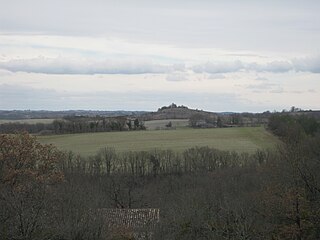
The Hôtel des Invalides, commonly called Les Invalides, is a complex of buildings in the 7th arrondissement of Paris, France, containing museums and monuments, all relating to the military history of France, as well as a hospital and an Old Soldiers' retirement home, the building's original purpose. The buildings house the Musée de l'Armée, the military museum of the Army of France, the Musée des Plans-Reliefs, and the Musée d'Histoire Contemporaine. The complex also includes the former hospital chapel, now national cathedral of the French military, and the adjacent former Royal Chapel known as the Dôme des Invalides, the tallest church building in Paris at a height of 107 meters. The latter has been converted into a shrine of some of France's leading military figures, most notably the tomb of Napoleon.

Vitrolles is a commune in the Bouches-du-Rhône département in the Provence-Alpes-Côte d'Azur region in southern France, located about 20.6 km (12.8 mi) from Marseille. It is the largest suburb of the city of Aix-en-Provence and is adjacent to its southwest side.

The Prix de Rome or Grand Prix de Rome was a French scholarship for arts students, initially for painters and sculptors, that was established in 1663 during the reign of Louis XIV of France. Winners were awarded a bursary that allowed them to stay in Rome for three to five years at the expense of the state. The prize was extended to architecture in 1720, music in 1803 and engraving in 1804. The prestigious award was abolished in 1968 by André Malraux, then Minister of Culture, following the May 68 riots that called for cultural change.

The police prefecture is the unit of the French Ministry of the Interior that provides police, emergency services, and various administrative services to the population of the city of Paris and the surrounding three suburban départements of Hauts-de-Seine, Seine-Saint-Denis, and Val-de-Marne. It is headed by the Prefect of Police.

Arbori is a commune in the Corse-du-Sud department of France on the island of Corsica.

Aullène is a commune in the Corse-du-Sud department of France on the island of Corsica.

La Porta is a commune in the Haute-Corse department of France on the island of Corsica.

Lascabanes is a former commune in the Lot department in south-western France. On 1 January 2018, it was merged into the new commune of Lendou-en-Quercy.
The Commission des Sciences et des Arts was a French scientific and artistic institute. Established on 16 March 1798, it consisted of 167 members, of which all but 16 joined Napoleon Bonaparte's campaign in Egypt and produced the Description de l'Égypte. More than half were engineers and technicians, including 21 mathematicians, 3 astronomers, 17 civil engineers, 13 naturalists and mining engineers, geographers, 3 gunpowder engineers, 4 architects, 8 artists, 10 mechanical artists, 1 sculptor, 15 interpreters, 10 men of letters, 22 printers in Latin, Greek and Arabic characters. Bonaparte organised his scientific 'corps' like an army, dividing its members into 5 categories and assigning to each member a military rank and a defined military role beyond his scientific function.
The Minister for the Maison du Roi was a cabinet role under the French monarchy, conferring leadership of the Maison du Roi.














